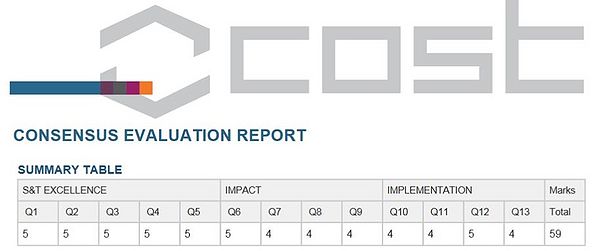Difference between revisions of "MITOEAGLE evaluation highlights"
From Bioblast
| Line 33: | Line 33: | ||
::::» [[Media:MITOEAGLE_COST-Evaluation2016-02-12.pdf |MITOEAGLE_COST-Evaluation2016-02-12.pdf]]. | ::::» [[Media:MITOEAGLE_COST-Evaluation2016-02-12.pdf |MITOEAGLE_COST-Evaluation2016-02-12.pdf]]. | ||
[[File:MITOEAGLE evaluation-highlights.jpg| | [[File:MITOEAGLE evaluation-highlights.jpg|600px|From the MITOEAGLE COST Consensus Evaluation Report]] | ||
Revision as of 16:32, 12 May 2016
| News and Events | Working Groups | Short-Term Scientific Missions | Management Committee | Members |
COST Action CA15203 (2016-2021): MitoEAGLE
Evolution-Age-Gender-Lifestyle-Environment: mitochondrial fitness mapping
MITOEAGLE evaluation highlights
- The large number of proposers spread across many EU countries and employed in a range of sectors is an early indication of the relevance and timeliness of this study.
Highlights: The main strengths are
- The idea of establishing a standardized database of mitochondrial data, with continuous monitoring and updating of SOPs.
- The set up of data sets for mt-function for different tissues in a standardized format.
- The ambition to coordinate researchers whose research activity is focused on mitochondrial physiology, but that work in different fields.
- The will to go beyond the spirit of strong competition that characterized research on mitochondria.
- The proposal addresses the considerable lack of uniformity and consensus on standard operating procedures in the design and implementation of research protocols involving mitochondrial physiology. This is a very real problem that can only be solved through networks on a scale such as this Action, that will work to harmonise experimental protocols across research groups.
- The will to reach standardized protocols and ways of data presentation, that will allow an easy cross comparison of data; this aim has been reached in many other fields of research (e.g flow cytometry data, microarray analysis).
- The ambition to pool together data from different groups, in order to get the statistical power that could not be reached by single, small research groups.
- To the best of my knowledge, I cannot remember similar networks in Europe, in terms of dimensions and ambition.
- Several significant risks to the successful completion of the Action have been identified. These include the difficulty in standardising experimental protocols, variability in quality control standards and failure of the consortium to agree on specific standards.
- The breadth of membership that is already evident in this consortium underscores the importance and significance of the aims and objectives of this Action.
Highlights: Suggestions by reviewers
- The inclusion of a WP with specific responsibility for dissemination and training could be considered. - For example, the education programme for use of the MITOEAGLE data base could be the responsibility of the new WP.
- This Action will benefit from a more comprehensive analysis of its long term impact on European society; as an example, the proponents say that this Action will help to distinguish noise from truth in the field of mitochondrial biology: many "noisy data" on mitochondria and the process of aging, which has a crucial impact on the society and economies of Europe.
Comment of the Scientific Committee
- The proposed Action must develop and implement specific plans to increase the involvement of Early Career Investigators and for maintaining and monitoring gender balance.




